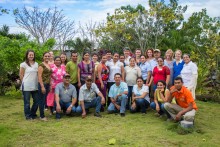Equal Exchange is proudly supporting the Coffee Quality Institute’s Gender Equity program as a Sustaining Partner. Equal Exchange Coffee Quality Manager Beth Ann Caspersen participated in the second of four international workshops in Palacaguina, Nicaragua in January.
This is the second of two blog posts about the experience. Read the first post here.
How do you tackle an enormous topic like gender equity in the male-dominated coffee industry? This is exactly what the Coffee Quality Institute is working toward through a series of workshops that bring together men and women from both the producing and consuming sides of the supply chain. I attended the workshop in January, and over the course of three days, we spent time with women on their coffee farms and later engaged with a mixed group of participants to work through difficult questions using a methodology called the Gender Action Learning System (GALS).
I have seen some of the effects of the GALS system in Uganda with women at the Gumutindo Cooperative, but I didn’t know how the system worked. During my November visit to Uganda, I was meeting with a group of women at Gumutindo and noticed that there was an increase in the number of women’s groups and that they had formed small savings and loan groups. I was impressed by these developments and they told me it was their training in the GALS system that had cultivated these groups. Having witnessed this change, I decided to learn more about how the GALS system works, to support CQI’s efforts in bringing this training to different countries and to gain a deeper understanding of how I, as a woman, and how Equal Exchange, as a worker co-op, could learn from these efforts. An elevated level of participation in decision making and a focus on saving money are efforts that I wanted to be part of, globally.
The Workshop: In Photos
GALS is an interactive training mechanism that includes individual and group activities to discuss complex issues in the household. This approach is hands-on and doesn’t require participants to have a high level of education as many of the exercises are executed with the use of graphics, physical movement and pictures to demonstrate the division of labor and decision making in the home. Our facilitators utilized this framework and included their own experiences, to create an inclusive workshop that was highly participatory, created a safe space to share, and the air was filled with respect. Together with 27 participants, representing men and women coffee farmers of various ages, co-op administrators, financing organizations, development organizations, and U.S.-based coffee professionals, we engaged in a two-day workshop to begin to tackle these complex issues.
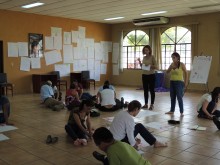
I have been to a lot of sedentary workshops where you sit in chair and spend some time in groups and lots of time listening. This workshop was nothing like that! The space was a large, open room and we were up and moving immediately; we were engaged in a way that I was not accustomed to and it was a refreshing change that activated my mind and my body immediately.
Reglas de Oro/Rules of Gold

Tree Series
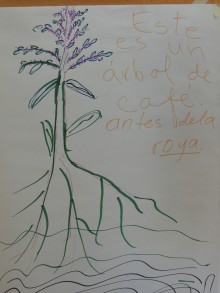
The Structure of the Gender Balance Tree

Trunk = people living in the home (mom, dad, kids, extended family) and joint decisions (graphics outside of the tree would indicate that the decisions are made by individuals).
Roots = distribution of work activities, i.e. cooking, cleaning, work on the farm, etc.
Women are represented on the left, men on the right, and shared responsibilities in the middle.
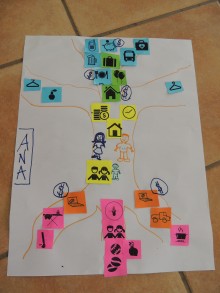
We were then instructed to stand in the formation of our tree. Looking around the room of human trees, each person looked for similar structures and formed small groups based on the structure to then create our combined tree. As a group we then talked about how we could create a more balanced tree in the home. What can we do differently, how can we improve or change the balance of our tree?
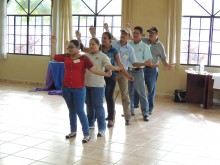
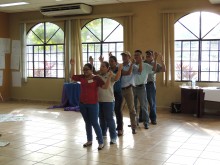
The following morning started with a vision quest: Where do you see yourself and your organization in 10 years? We created pictures of our hopes and aspirations for change to then divided into small groups to create a road map with concrete actions.
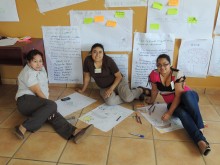
I was in the international group and we found ourselves talking about the role of coffee roasters and the end consumer of which we identified both the consumers as a key part of the equation along with the persistent need for resources and training.
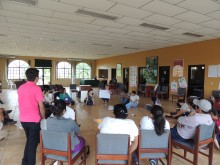
Our Road Map
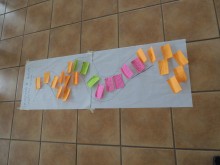
The roadmap, along with all of the information we generated, will be transformed into a report with the outcomes of this workshop. CQI’s goal is to combine the information from all four workshops in Colombia, Nicaragua, Uganda and Indonesia to highlight the importance of Gender Equity and provide a holistic roadmap for the coffee industry on ways to improve the status quo.
We concluded our workshop in a circle holding hands and talking about what we are going to do next. I said that I was going to return to the U.S. and share the story of our workshop with the coffee industry and utilize the tools I have learned in my work. This is one step toward that goal, but my vision transcends the coffee industry; I hope to see how this work can educate and improve the decision-making power women have all over the world. It is a long, slow process that could take a generation, but I am committed to making it happen.
